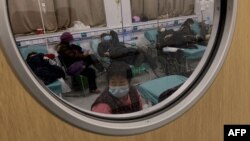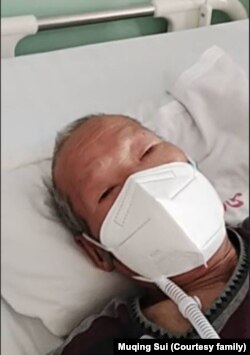Taixing, a city of nearly 1 million people in Jiangsu Province, is richly red in Chinese Communist Party history, landmarks and revolutionary traditions.
On Wenchang West Road, there's a noteworthy new marker: the crematorium attached to the Taixing Funeral Parlor. According to local residents, there are at least seven furnaces transforming hundreds of individually labeled corpses into ashes each day.
So busy is the Taixing Funeral Parlor that the body of Jun Cheng's uncle, believed to be about 80 years old when he died December 29, remained at home for four days before cremation. Mr. Z, as family asked VOA Mandarin to refer to him as a courtesy, lived only two or three days after contracting COVID-19.
"My uncle couldn't breathe well, and he suffocated himself alive, with white lungs," said Cheng. "The local Hongqiao Hospital refused to state that the death was caused by coronavirus disease." White lungs refer to how COVID-19 appears on a scan or an X-ray.
The National Health Commission announced on December 25 that it would stop publishing daily numbers of people infected with the virus and numbers of deaths. Instead, Chinese Centers for Disease Control and Prevention would release the epidemic data. Authorities now report nearly 60,000 COVID-related deaths since lifting the "zero-COVID" policy.
According to the criteria set by Chinese authorities, only pneumonia and respiratory failure caused by the virus are classified as COVID deaths.
But when formerly tough-talking China reversed its zero-COVID policy on December 7 after almost three years of lockdowns, involuntary quarantines and travel restrictions, the virus rampaged through the population as Beijing spoke vaguely of "living with" the disease.
Richard H. Ebright, a professor of chemistry and chemical biology at Rutgers University and laboratory director at the Waksman Institute of Microbiology, told VOA Mandarin that the emergence of variants having significantly higher transmissibility than Wuhan-1, particularly delta in 2021 and omicron in 2022, made China's reliance on a "zero-COVID" policy difficult by late 2021 and impossible by late 2022.
"Without an effective and comprehensive vaccination program in 2021 and 2022, and with the abandonment of its zero-COVID policy at the end of 2022, China now likely will suffer catastrophic impacts," he said. "China failed expensively and spectacularly."
Ebright said that even as other countries in the region such as Taiwan, Singapore, South Korea, Japan, New Zealand and Australia conducted widespread vaccination campaigns with particular emphasis on vulnerable populations such as the elderly, China insisted on pursuing zero-COVID. The policy was President Xi Jinping's signature public health measure of the pandemic.
The number of deaths "can be said to be an eternal mystery," Cheng, a retired businessman, told VOA Mandarin. "They died for no reason, and they are not even statistics now."
Although China's National Health Commission disclosed on January 12 that there had been close to 60,000 COVID-related deaths, which dwarfed the previous total of several dozen, experts contend the toll is likely even higher. Airfinity, a U.K.-based predictive health analytics data company, is expecting the toll to peak at 36,000 deaths per day on January 26 and estimates 608,000 cumulative deaths from December 1 through January 17.
China's state-run Xinhua news agency said the optimization of China's COVID response policies is science-based, effective and consistent with the country's national realities.
At the time of publication, none of the funeral homes and hospitals mentioned here has responded to requests for interviews or questions from VOA Mandarin.
A very long line
On January 2, Cheng's family members arrived at the crematorium in darkness at 5 a.m. Cheng said that the queue formed an S-shape, and there was no special car to pick up and drop off corpses. When the family joined the queue, they carried Mr. Z's body, and as a group, were assigned number 88.
They emerged into sunlight at 9:30 a.m. with Mr. Z's ashes.
Cheng said that other people waiting to have a relative cremated told him, "The hospital said, 'We dare not write the cause of death as COVID. If we do, we will be dismissed.'"
He told VOA Mandarin, "All Chinese are deceiving themselves and others."
According to staffers of Xuanbao Funeral Home in Taixing, their workload has doubled or maybe tripled from what it was before the epidemic. Eleven of them worked from midnight to noon or even 2 p.m. or 3 p.m. for 11 consecutive days, said one who spoke to VOA Mandarin on the condition of anonymity because they wanted to keep their job.
'It doesn't make sense'
In Tianjin, a port city of some 16 million people in northeastern China that is celebrated for its fried dough twists known as mahua, Mr. X is bewildered by the strangeness of his days and overcome with grief. Like many people interviewed for this report, he did not want to be identified to avoid attracting official attention.
He told VOA Mandarin that on December 5, he learned that everyone in a friend's family in Zhangjiakou, Hebei Province, found out they were infected. Mr. X wondered aloud to VOA Mandarin, "Why hadn't the outbreak happened earlier? Why all of a sudden, was the entire country, even a small village in a corner, infected?
"It doesn't make sense," he added. "The news was opaque. All parties concealed it, resulting in a lot of public speculation and lies."
With a sigh, Mr. X said, "I'm just kind of full of grief and anger, thinking that my father is gone and left forever."
His father started to have a fever about December 17, and his blood oxygen saturation decreased. He entered Tianjin Hospital for emergency treatment on December 25 and died four days later.
'No way out'
In the Central Hospital of Tonghua, Jilin Province, 1,000 kilometers away from Tianjin, 940 kilometers from Beijing, and right across the Tumen River from North Korea, Chinese human rights lawyer Sui Muqing said that the two doctors in charge of his father's ward were both infected with COVID.
Sui's father, Shuyan Sui, contracted COVID after being admitted to the hospital in mid-to-late December for an illness unrelated to COVID.
"The doctor told us (he had) white lungs, there is no way out," Sui told VOA Mandarin.
The elder Sui's life played out against the emergence of modern China. Born during the humiliation of the Sino-Japanese war, he died on Christmas Day, a citizen of a global superpower.
Sui said, "My father was very clear-minded and had a strong will to survive. He discussed with us about sending him to the hospital in Changchun, 861 kilometers from Beijing, but the hospital in the big city couldn't admit him. My father told me, 'I'm dying.' I felt so sad. He wished I could save him, but I couldn't."
Sui suggested that the Chinese government only considers getting past the peak of the current outbreak so that most people have been infected. "If you have antibodies, you can work soon and save the economy," he told VOA Mandarin.
"The prosperity of the funeral industry is a great thing for the country [because it] greatly reduces the financial burden of pensions and feeding [a large elderly population]. It is a very sad thing for each of our families," he said.
In Sui's eyes, zero-COVID failed. "It cleared our wallets, freedom, dignity, and our parents, but it didn't clear the virus. We revisited the Great Leap Forward and the Cultural Revolution again, making up for the price we didn't pay."
An estimated 30 million people died of starvation during the Great Leap Forward from 1960-1962, and between 750,000 and 2 million were killed during the violent social unrest of the Cultural Revolution from 1966-1976.
'The tragedy has never stopped'
At the end of December, Ms. Wang, who asked VOA Mandarin to use only part of her name to avoid drawing official attention to her, visited hospitals in Wuhan.
She said the visits were painful. In some hospitals, there were no beds and no oxygen cylinders for people struggling to breathe.
"Three years ago, the cause of death was unclear, and now it is still unclear. Disasters have been repeating themselves, and the tragedy has never stopped."
VOA journalists Jiha Ham of the Korean Service and Adrianna Zhang of the Mandarin Service contributed to this report.















